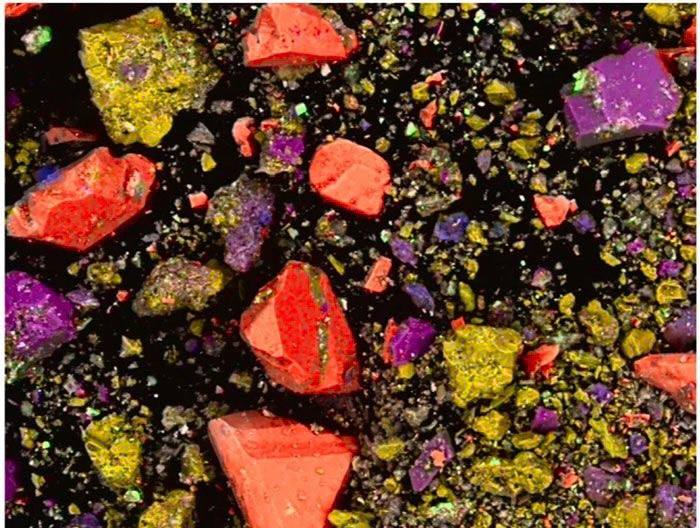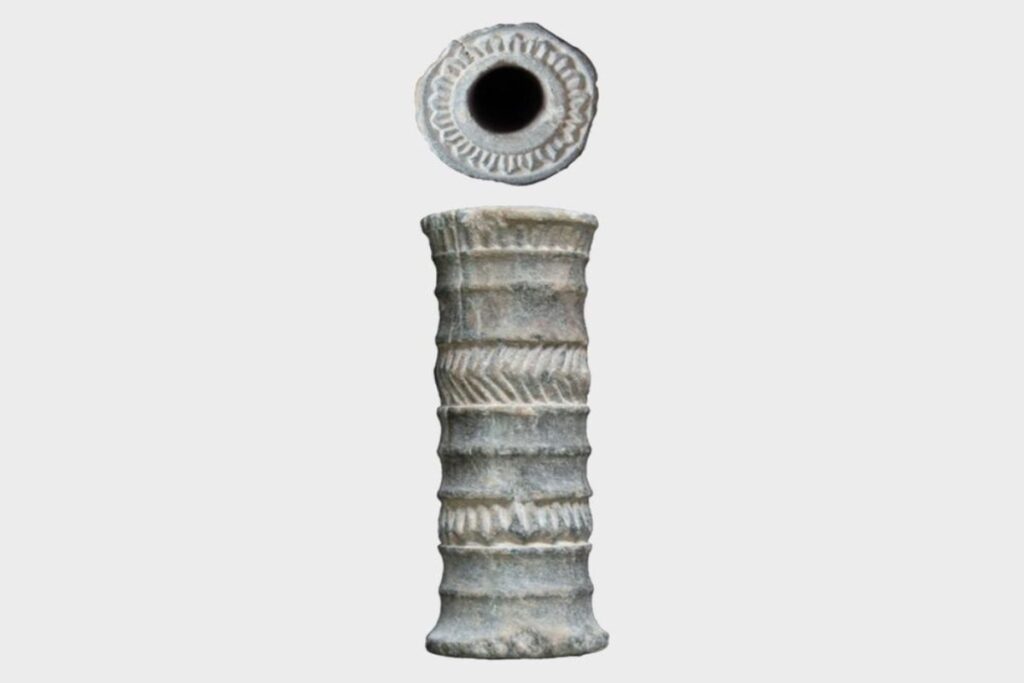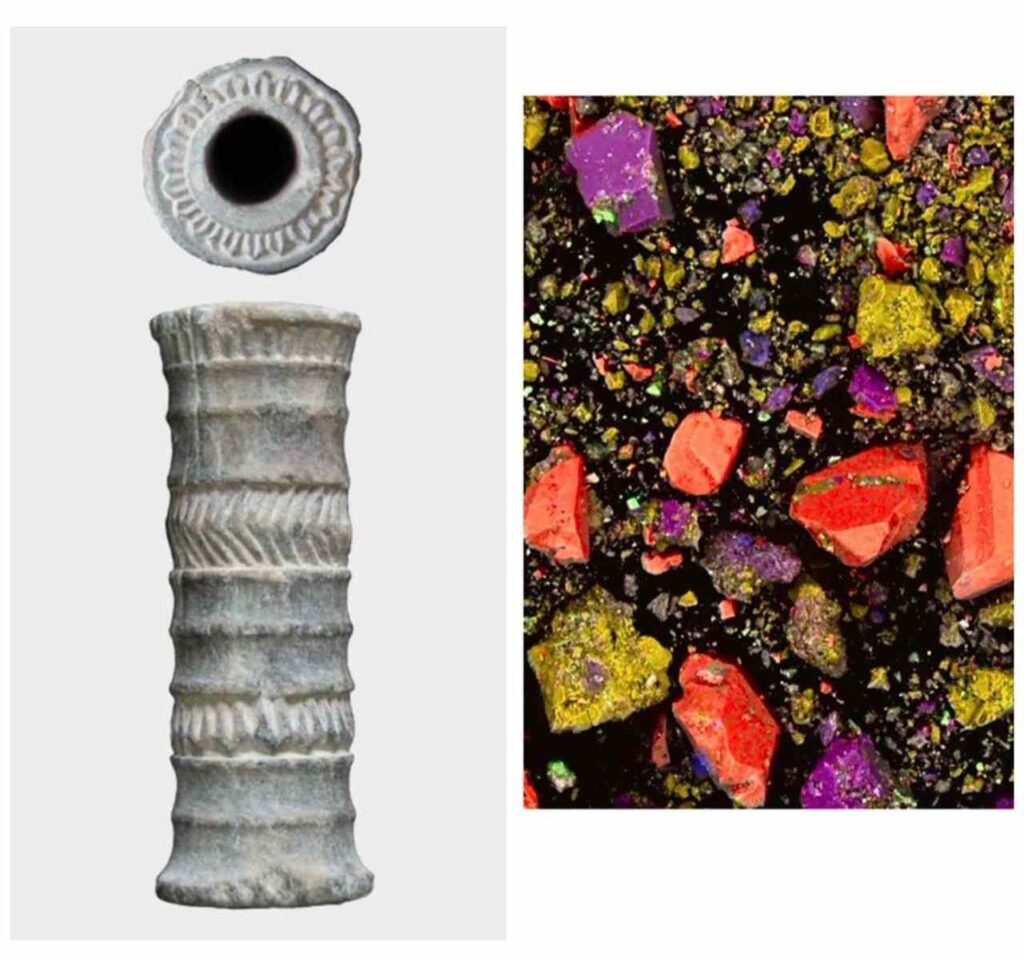Archaeologists found a small stone bottle in southeastern Iran with some red cosmetics. After its discovery, they researched the vial and its contents. They think people used it as lip color around 4,000 years ago.
According to Scientific reports, the rare find is “probably the earliest” scientifically documented and analyzed lipstick. The substance found in the stone vial comprises different minerals.
What Is the Ancient Red Cosmetic Is Made Of?
The report explains that more than 80% of the analyzed sample comprised minerals that produce a deep red color, primarily hematite.

This makeup mixture was also red-colored and contained manganite and braunite, dark-colored minerals. The researchers also found traces of other minerals and waxy substances from plants and other organic materials.
“Both the intensity of the red coloring minerals and the waxy substances are, surprisingly enough,” the study authors noted. “Fully compatible with recipes for contemporary lipsticks.”
ALSO READ: Study Shows Swapping Meat for Mushroom Protein May Reduce Cholesterol
Was the Found Cosmetic a Lipstick?
The lead study author, Massimo Vidale, an archaeologist at the University of Padua, says it’s hard to say the exact purpose of the cosmetic. According to Vidale, it could have been a blusher, too. However, he said the homogenous red color and the shape of the vial “suggested to us it was used for lips.”
Vidale also mentioned that this is one of the first instances where they’ve studied an ancient, red-colored cosmetic like this. He said they’re unsure why they haven’t found many lipsticks or similar makeup in archaeological discoveries.
“We have no idea for the moment. The deep red color we found is the first one we met,” Vidale said. “While several lighter-colored foundations and eye shadows had been identified before.”
Scholars Speak on the Possibility of the Vial Containing a Lipstick
Joann Fletcher, a professor in the University of York’s archaeology department, mentioned that they’ve found evidence of crushed red ocher. Fletcher says the red ocher, a hematite type, was used in ancient Egyptian cosmetic vessels and even on stone cosmetic palettes from the late Neolithic period.
She said that whether the vial from Iran was the earliest lipstick, “all comes down to what this discovery was used for.”

“It is possible the contents of the vial were used as a lip color,” Fletcher said. “But they could also have been applied to give color to the cheeks or for some other purpose, even if the vial looks like a modern lipstick tube.”
Also, Laurence Totelin, a Cardiff University professor who specializes in Greek and Roman science, technology, and medicine, thinks it’s possible that the artifact contained lipstick. Totelin, like Fletcher, was not part of the study. However, he said via email that “the recipe is not dissimilar to a modern one.” Hence, he asserted, “The deep red color is also what we would expect for lip makeup.”
“That said, the ingredients are also regularly found in the preparation of ancient medicines, and the vial’s shape is not inconsistent with a pharmaceutical use,” Totelin added.
Is the Cosmetic Artifact Harmful?
No, it is not. Other ancient cosmetics found in Egypt and the Middle East included black kohl eyeliners and lighter-colored compounds used as eye shadows or foundations. But what’s interesting is that, unlike those cosmetics, the lipstick they found had a low lead content.
The researchers think this might mean that people who made the lipstick understood that lead could be harmful if consumed. “There is a long and harsh debate among experts on the toxicity of lead compounds in cosmetics,” Vidale said.
ALSO READ: Study Reveals Mediterranean Diet and Exercise Improves Gut Health, Leads to Weight Loss
Earlier Research on Artifacts from the Same Region
Massimo Vidale has been a part of earlier research on artifacts from the same region. The research found that about 5,000 years ago, they used white lead as the main ingredient in facial foundations. The deep red preparation they found, which they thought was for lips, had hardly any lead.
The preparation they found contained quartz particles, which could have come from ground sand or crystal. The study suggested that these particles might have been added to give it a shimmery effect. It’s also possible that the quartz particles came from the vial, which is made of a greenish stone.
“It’s also not clear what the original consistency of the cosmetic would have been fluid or more solid,” Vidale said.
Who Could Have Worn the Discovered Lipstick
It’s unclear who would have worn the lipstick or in what context. “As far as we know, cosmetics were regularly deposited near the face of the deceased in the graves of the time,” Vidale said. However, given the looting and destruction of the graves, researchers have not been able to link the artifact with specific human remains.
You Might Also Like:
The Way Americans Buy and Sell Homes Are About to Change
Toni Braxton Talks About Family’s Decision To Return to Reality TV After Sister’s Tragic Death
“Raise the White Flag,” Pope Francis Urges Ukraine to Surrender to Russia
Donald Trump Attorneys Say He’s Struggling to Post $464 Million Bond in Civil Fraud Case
63-Year-Old Valerie Bertinelli Speaks on Finding Love Again With “Very Special Man”
